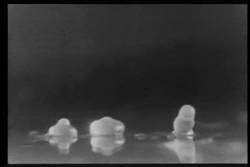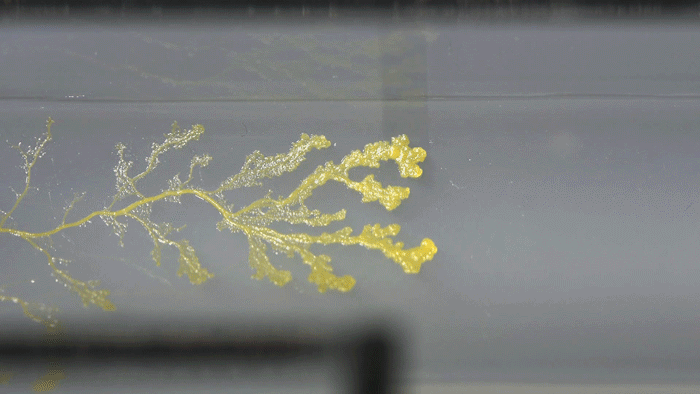Biology concepts – Protista, fungus-like protists, penicillin, undulipodia, serendipity, potato famine, networks, co-evolution, slime mold
Now it gets interesting. Some researchers noticed (serendipity?) that some of the fruiting body spores contained bacteria, but only some of them. Were they a contaminant? When the scientists killed off the bacteria nothing bad happened, but they noticed that the spores of the progeny that had contained bacteria also sported some bacteria in their newly formed spores.
Goss, E., Tabima, J., Cooke, D., Restrepo, S., Fry, W., Forbes, G., Fieland, V., Cardenas, M., & Grunwald, N. (2014). The Irish potato famine pathogen Phytophthora infestans originated in central Mexico rather than the Andes Proceedings of the National Academy of Sciences, 111 (24), 8791-8796 DOI: 10.1073/pnas.1401884111
Tero, A., Takagi, S., Saigusa, T., Ito, K., Bebber, D., Fricker, M., Yumiki, K., Kobayashi, R., & Nakagaki, T. (2010). Rules for Biologically Inspired Adaptive Network Design Science, 327 (5964), 439-442 DOI: 10.1126/science.1177894
Toshiyuki Nakagaki, Hiroyasu Yamada & Ágota Tóth (2000). Intelligence: Maze-solving by an amoeboid organism Nature, 407 (470)
Brock, D., Read, S., Bozhchenko, A., Queller, D., & Strassmann, J. (2013). Social amoeba farmers carry defensive symbionts to protect and privatize their crops Nature Communications, 4 DOI: 10.1038/ncomms3385
Brock, D., Douglas, T., Queller, D., & Strassmann, J. (2011). Primitive agriculture in a social amoeba Nature, 469 (7330), 393-396 DOI: 10.1038/nature09668
Serendipity plays a crucial role in doing science, and there are myriad examples of how scientists have discovered one thing while looking for something else. Penicillin is a good example. Alexander Fleming had an awful time keeping extraneous organisms from growing on his bacterial agar plates. It was his prepared mind that recognized that the mold (penicillium) growing on one of them had cleared the bacteria away in a wide circle.
Today we have an example of serendipity in story-telling. I set out to continue our story of undulipodia(flagella and cilia) use in the different types of organisms. We had used the undulipodia to talk about how hard it is to classify protists, first animal-like protists, then plant-like organisms, and today the fungus-ish protists.
However, in terms of undulipodia, the fungal-like protists are pretty much all the same. They all use flagella to propel their gamete cells. It’s interesting that some fungal cells are motile, but it’s not the most interesting thing in their story. In looking at the three phyla of fungus-like protists, I found that the biology of each is amazing – see if you agree.
Phylum Acraisomycota– As unappealing as it may sound, this phylum consists of the cellular slime molds. These protists spend much of their life as individual cells, moving around via amoeboid motion through the soil, looking for decaying organic material and bacteria to eat. But when hunger, they become ranchers. Yee-ha!
When about 100,000 cells join together to form a grex or a slug, they all move as one to try and find food, and to produce reproductive bodies so that their progeny will be protected, waiting as spores for better conditions. Without the benefit of speech or sign language, the single cells will start to take on different jobs, including building stalks that stick up into the air with fruiting bodies on top.
Inside the fruiting bodies are the spores, the progeny cells inside protective cellulose spore coats. They are environmentally resistant in this form and can wait until the conditions are right to become amoeboid cells of the next generation.
 |
After forming a slug, fruiting bodies will be formed on top of D. discoidium stalks. Remember that the individual cells are organisms, but they act like a multicellular organism. |
Their 2011 paper showed that some of the dictyostelium cells were not eating all the bacteria available; they were letting them reproduce and then storing them in their spores. When those spores were blown or carried to new locations and germinated, the bacteria would grow as well, becoming food for the cells. In turn, their progeny would be gathered into the next generation of spores.
Protist ranchers are amazing enough, but there’s more. The ranchers hire cowhands to protect their herd. The spores contain not only the food bacteria, but some other bacteria as well. These other bacteria (of the family Burkholderia) secrete chemicals that keep the non-ranching clones of dictyostelium from rustling the bacterial cattle. Not only are some of the protists ranchers, they protect what they raise using armed guards! It only took us several hundred million years to catch up to them.
Phylum Myxomycota - These are the acellular slime molds. The individuals cells don’t join together just when food is scarce, they spend most of their lives all packed together.
A good, if not so pleasantly named, example of the myxomycota is the dog vomit mold (Physarum polycephalum). It’s named that because it often looks like that. But the skills of this slimy mass help it to overcome the poor name and the yellow gooeyness (gooiness?). Acellular slime molds are math geniuses – and they are going to help you avoid your math homework by playing on the internet.
It all started when a 2000 paper showed that dog vomit mold can find its way through a maze. With food at the opposite end of a labyrinth, P. polycephalum will consistently find the shortest path to the food. The mold grows toward food in such a way as to be most efficient.
Here, efficient means using the least amount resources and the quickest route, ie. the shortest path. It creates a redundant system as well – more than one way to get to the target in case the primary path is disrupted by a misplaced footstep or a carelessly discarded whoopie pie wrapper (I must be hungry).
Finding fast, short, efficient, and redundant paths involves high level math - very high level math. P. polycephalum doesn’t have a calculator, or even a brain, but we're learning a lot from this mathlete.
In an amazing 2010 study, pieces of food were placed on an agar plate in the relative locations of Japanese towns around Tokyo. A small amount of P. polycephalum was placed where Tokyo would be, and it was allowed to grow toward the food. The result – the mold recapitulated the Tokyo rail system map!!! Five dollars worth of agar and 48 hours achieved the same design result as years of time and hundreds of millions of Japanese yen – maybe just a bit embarrassing?
Graphics programs use slime mold math to build geometric shapes which become smooth and realistic surfaces and moving objects in your video game. Dog vomit mold can even be used to model the movements of characters within the games. Who knew that Assassin’s Creed involved so much math?
Phylum Oomycota - These are the water molds or downy mildews. We have talked about them before in terms of their presence in your bathtub and shower, but they have more stories to tell. For instance, they were responsible for the number of Irish Catholic priests in America.
One of the most amazing things about this phylum is that you pronounce both of the first two O’s – say “Oh! Oh! Mycota” real fast. The name means “egg fungi,” and as with the two other phyla, they used to be mistaken for fungi. However, these molds grow in long filaments, not as slime molds.
You can directly relate the number of Irish priests in America to an oomycota called Phytophthora infestans. The land in Ireland in the 1700-1800’s was particularly fertile; they were the breadbasket of the UK. This meant that they grew a lot of potatoes. True, the English land owners took most of the crop, but the Irish that worked the land benefited as well by having more food than most other people in their sociopolitical group could manage.
Because they had more food, they had better overall health. Better health led to, amongst other things, more children. The population growth in Ireland was much higher than in other parts of the UK. Then a ship arrived with P. infestans in 1845 and the Great Famine followed in its wake.
P. infestans wasn’t a problem for the potatoes growing the Americas because the parasite and the potato had co-evolved, every mutation that made the protist more dangerous to the potato was countered by a potato mutation to increase their defense. This was possible because, as we have discussed before, the potato is one of the crops native only to the Americas.
Historically, a ship from South America Andes has been blamed for bringing the ill-fated protozoan to Ireland, but 2014 research on genetics shows that the particular P. infestans that went to Ireland probably developed in central Mexico.
Regardless of where it came from, the European potato cultivars had not been pressured to develop defenses against P. infestans, and they rotted in the ground in a disease called late blight of potato. More than one million people died in 1847. To survive, millions left Ireland. Many came to America.
With their new land, the Irish adopted a new attitude. So many children had been lost to the potato blight that they began to rethink the idea of large families. They looked to the teachings of economist Thomas Malthus for ways to have fewer children and still remain true to their Catholic beliefs.
Malthus said that people could reduce their population growth by marrying later, by going into public service, or by joining the clergy. So many Irish boys became priests or policemen. By the 1870’s, over 80% of priests ordained in America were from Irish families. A protozoan parasite led directly to Barry Fitzgerald's and Bing Crosby's characters in Going My Way.
Do you agree that those are some amazing stories? If you didn’t already love biology, I bet you do now. Let’s bring Christmas into this lovefest next week. Your evergreen Christmas tree actually fights off the Sun in winter time; it could die otherwise.
Goss, E., Tabima, J., Cooke, D., Restrepo, S., Fry, W., Forbes, G., Fieland, V., Cardenas, M., & Grunwald, N. (2014). The Irish potato famine pathogen Phytophthora infestans originated in central Mexico rather than the Andes Proceedings of the National Academy of Sciences, 111 (24), 8791-8796 DOI: 10.1073/pnas.1401884111
Tero, A., Takagi, S., Saigusa, T., Ito, K., Bebber, D., Fricker, M., Yumiki, K., Kobayashi, R., & Nakagaki, T. (2010). Rules for Biologically Inspired Adaptive Network Design Science, 327 (5964), 439-442 DOI: 10.1126/science.1177894
For more information or classroom activities, see:
Serendipity in science –
Slime molds –
Potato famine –























